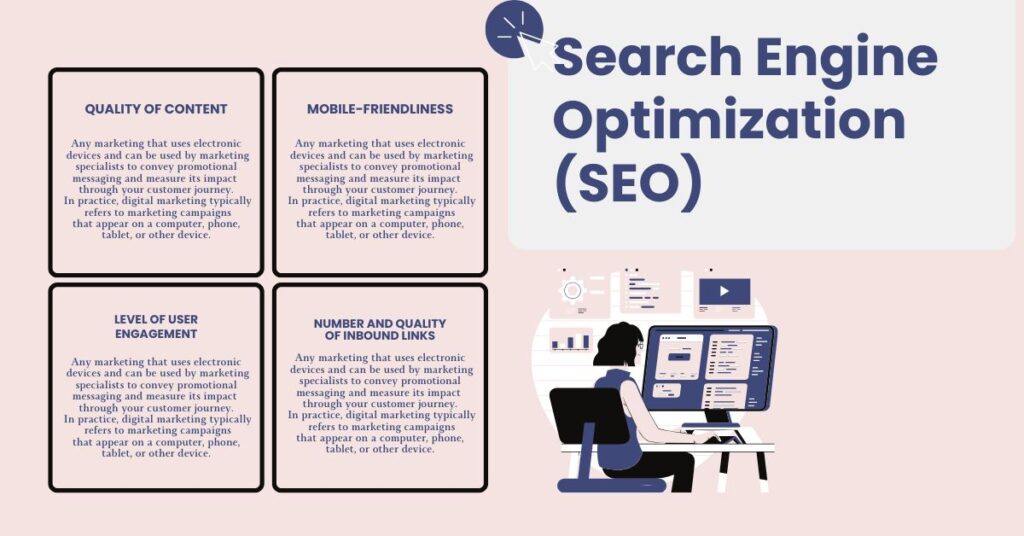SEO in Digital Marketing
SEO in Digital Marketing Explained: Key Techniques for Online Growth Search Engine Optimization (SEO) stands as a cornerstone of modern digital marketing, yet for many newcomers, its complexities can seem daunting. This report aims to demystify SEO, providing a clear, human-friendly explanation of its core principles, how it operates, its various facets, and its profound impact on online visibility and business growth. It explores the foundational processes that search engines employ, differentiates SEO in Digital Marketing from paid advertising, and examines how this dynamic field continues to evolve with technological advancements and shifting user behaviors. What is SEO? In the expansive landscape of digital marketing, the term “SEO in digital marketing” frequently arises, often sparking curiosity about its true meaning and function. At its heart, SEO, or Search Engine Optimization, is a strategic process designed to enhance a website’s presence and position within search engine results pages (SERPs). The fundamental purpose of SEO in digital marketing is to help search engines, such as Google, understand a website’s content more effectively. This, in turn, enables users to discover the site when conducting online searches. The ultimate goal is to attract organic traffic—visitors who arrive at a website through unpaid, natural search results. The compelling aspect of SEO lies in its ability to generate sustained visibility without the direct, per-click costs associated with paid advertising. This distinction highlights SEO’s role in building a durable digital asset. Unlike marketing efforts where traffic ceases once a budget is depleted, successful SEO initiatives continue to deliver traffic and enhance visibility over extended periods, accumulating benefits over time. This positions SEO not merely as an expenditure but as a strategic investment in a long-term, self-sustaining channel for growth, fundamentally contributing to a business’s online real estate and its continuous generation of leads and sales. SEO in Digital Marketing:- The Magic Behind the Scenes: How Search Engines Work To truly grasp the essence of SEO, it is essential to understand the underlying mechanisms of search engines. These powerful systems are not enigmatic black boxes; rather, they operate through a logical, multi-step process to organize the vast expanse of information available on the internet. One can visualize a search engine as a highly efficient librarian overseeing an immense digital library. This librarian employs a dedicated team of assistants (crawlers) to locate new books (web pages), meticulously catalog and arrange them (indexing), and then, upon a user’s request for a specific topic, recommend the most relevant and highest-quality books (ranking). In order to complete the process, there are three crucial processes that occur in sequential order: crawling, indexing, and ranking. Each stage is interdependent, meaning a successful outcome in an earlier step is a prerequisite for progression to the next. A page cannot be indexed if it is not crawled. If it is not indexed, it simply cannot appear in search results for any query. This sequential dependency underscores that SEO is a holistic, pipeline-driven process where foundational elements are absolute necessities for any content or off-page strategy to yield results. Crawling Crawling represents the initial discovery phase. During this stage, search engines deploy automated programs, often referred to as “web crawlers,” “spiders,” “robots,” or “Googlebot,” to systematically explore the internet. Their primary mission is to identify new web pages and detect updates to existing ones. Crawlers navigate the web by following links they have previously discovered or by utilizing sitemaps provided by website owners. As they traverse the web, these programs download all the content on a page, including text, images, and videos. Crucially, they also render the page and execute JavaScript, mirroring how a standard web browser would, to ensure they perceive and comprehend all content visible to a user. It is important to note that not all pages are crawled; website owners can intentionally block certain pages using directives like robots.txt files, or some pages may require logins, rendering them inaccessible to crawlers. Indexing Following a successful crawl, the indexing phase commences. At this point, the search engine decides if the content that has been crawled is “worthy” enough to be added to its enormous database, or “index.” This index functions as a comprehensive digital library catalog. During indexing, Google meticulously analyzes all the downloaded data, encompassing text, HTML, CSS, and vital elements such as title tags and alt attributes. This analysis allows the search engine to form a thorough understanding, or “image,” of the page’s content. A significant component of this process involves identifying and managing duplicate content. Google strives to present only the most representative, or “canonical,” version of a piece of content, grouping similar pages and selecting the optimal one for display in search results. Based on this detailed processing, Google determines whether to index a page, making it eligible for ranking. Ranking The final and often most anticipated stage is ranking. When a user inputs a query into a search engine, the ranking process determines which pages from the index are most pertinent and valuable, and in what sequence they should appear on the search results page. Google’s sophisticated systems scour their vast index for pages that align with the user’s query. Subsequently, they apply hundreds of ranking factors to assess the quality and relevance of these pages. These factors are diverse and can include the user’s geographical location, the language of the search, the device being used (desktop or mobile), and, critically, the inherent quality and authority of the content itself. The details of the question can even cause the search results page to change dynamically. The continuous emphasis on search engines’ “understanding” and “seeing the page like a user” implies that they are not merely passive data collectors. Instead, they actively attempt to interpret and experience website content. Consequently, SEO transcends mere technical compliance; it involves making a website’s value and purpose unambiguously clear, logically structured, and fully accessible to an intelligent, albeit non-human, system. This is akin to translating a website’s essence into a language that search engines can efficiently process and interpret, ensuring no valuable content is overlooked due

